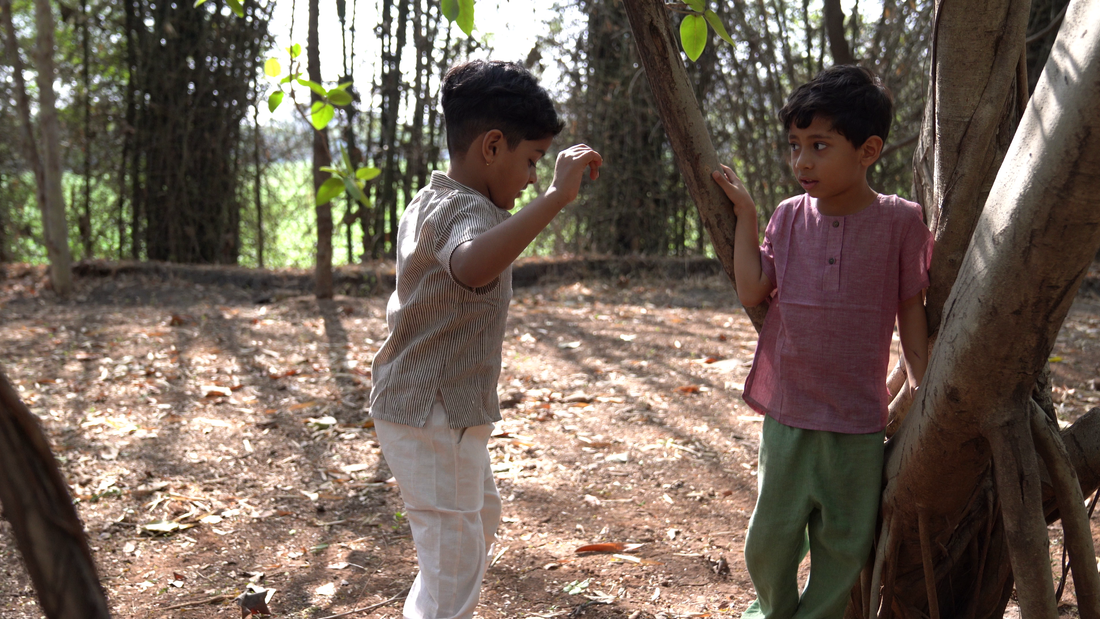
Why Nature Walks Are Essential in Early Childhood
Share
Imagine a world where your child’s classroom has no walls, the curriculum is written in petals and puddles, and learning flows as naturally as the wind. That’s the essence of Waldorf education in early childhood — where nature isn’t just a backdrop for learning, it is the learning environment.
Among the many nature-centered practices in Waldorf pedagogy, daily nature walks hold a unique place. They're not just for fresh air or burning off energy — they’re a vital rhythm, intentionally woven into a child’s developmental needs. Let’s explore five key reasons why nature walks are essential in early childhood, according to Waldorf principles, and supported by modern developmental science.
1. Deepens the Child’s Connection to Nature
Waldorf education, founded by Rudolf Steiner in the early 20th century, emphasizes nurturing a sense of reverence for the natural world. Young children are naturally inclined to connect with nature — to pick up stones, watch ants, and marvel at the way sunlight dances on water. Nature walks offer the space and freedom to cultivate this connection organically.
Steiner (1996) spoke of fostering "a living relationship with the world," and for young children, that begins in nature. When children are exposed daily to forests, gardens, or even neighborhood trees, they begin to feel at home in the world. This isn't just good for their soul — it's good for the planet. Early love of nature has been linked to lifelong environmental stewardship (Chawla, 2006).
2. Sparks Imagination and Creative Play
Waldorf pedagogy holds that the young child learns primarily through imitation and imaginative play, not through direct instruction or screens. Nature, unlike toy aisles or digital media, provides open-ended materials: sticks, leaves, puddles, and rocks can become anything in a child’s world.
As McAllen (1990) noted in her interpretation of Steiner’s work, young children need simple, unformed objects to project their imagination onto. On a nature walk, a stick isn’t just a stick — it’s a sword, a fishing rod, a walking companion, or a magical wand. In this open-ended space, symbolic thinking (a foundational skill for literacy and abstract thought) develops naturally.
3. Supports Physical and Sensory Development
Daily walks, even short ones, provide a powerful sensory experience. The texture of bark, the crunch of gravel, the feel of rain on skin - these are the inputs that nourish the developing nervous system.
Steiner (1996) emphasized the importance of physical activity in young children’s development, stating that movement is thinking in early childhood. Nature walks promote:
- Gross motor development through walking, climbing, balancing
- Sensory integration, as children interact with diverse natural stimuli
- Vestibular and proprioceptive development, crucial for spatial awareness and coordination
Modern research backs this up. Children who engage in regular outdoor play have been found to have better balance, agility, and coordination than those who don’t (Fjørtoft, 2004).
4. Builds Mindfulness, Observation & Inner Quiet
In Waldorf education, the quality of attention is considered more important than the quantity of information. Nature walks slow the child down — helping them notice rather than rush. A falling leaf, a worm in the soil, or a spiderweb catching dew becomes a quiet invitation to observe, wonder, and reflect.
This nurtures a foundation for mindfulness, emotional regulation, and patience — all increasingly rare in a culture of constant stimulation. Research confirms that time in nature can reduce symptoms of ADHD and increase focus in young children (Taylor & Kuo, 2009). In a Waldorf setting, this kind of quiet observation is not a bonus — it’s built into the daily rhythm.
5. Cultivates Rhythm, Resilience & Emotional Well-Being
Waldorf early childhood programs emphasize predictable daily and seasonal rhythms. A nature walk, especially when done at the same time each day, becomes a grounding ritual. It provides a child with the security of routine, while allowing for endless novelty in the natural world.
Emotionally, nature walks can:
- Calm anxious children through sensory input
- Encourage resilience by exposing them to changing weather and terrain
- Support mood regulation through movement and connection
Louv (2008) coined the term “Nature Deficit Disorder” to describe the emotional and behavioral challenges linked to lack of outdoor time. Waldorf’s nature-based rhythms are the antidote: slow, steady, and full of wonder.
Integrating Nature Walks at Home
Even if your child isn't in a Waldorf school, you can still integrate these principles at home. Here are a few ideas:
- Take a daily walk at the same time each day (e.g., after breakfast or before dinner).
- Leave toys behind — let nature be the playground.
- Model quiet observation — notice birds, trees, cloud shapes together.
- Name the seasons — talk about the changes you see, hear, and feel.
- Create rituals like singing a nature song at the start or collecting one “treasure” to bring home.
Remember, it’s not about distance or destination. It’s about presence. 🌾
Final Thoughts
In Waldorf pedagogy, nature isn’t an “extra” — it’s the very soil in which early childhood is rooted. Daily nature walks foster not just physical health or cognitive skills, but a child's whole being — their imagination, rhythm, emotional well-being, and reverence for the world.
As Steiner beautifully put it, “Receive the children in reverence, educate them in love, and send them forth in freedom.” What better place to begin that journey than under open skies, with bare feet on the earth, and stories carried on the wind?
References
- Chawla, L. (2006). Learning to love the natural world enough to protect it. Barn, 2, 57–78.
- Fjørtoft, I. (2004). Landscape as playscape: The effects of natural environments on children’s play and motor development. Children, Youth and Environments, 14(2), 21–44.
- Louv, R. (2008). Last child in the woods: Saving our children from nature-deficit disorder. Algonquin Books.
- McAllen, A. C. (1990). The child’s changing consciousness: As the basis of pedagogical practice. SteinerBooks.
- Steiner, R. (1996). The education of the child: And early lectures on education (G. & M. Adams, Trans.). Anthroposophic Press. (Original work published 1907)
- Taylor, A. F., & Kuo, F. E. (2009). Children with attention deficits concentrate better after a walk in the park. Journal of Attention Disorders, 12(5), 402–409. https://doi.org/10.1177/1087054708323000
